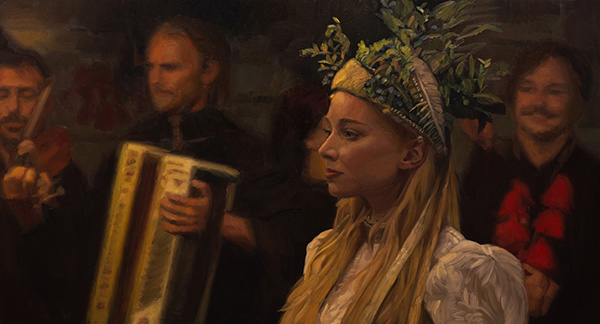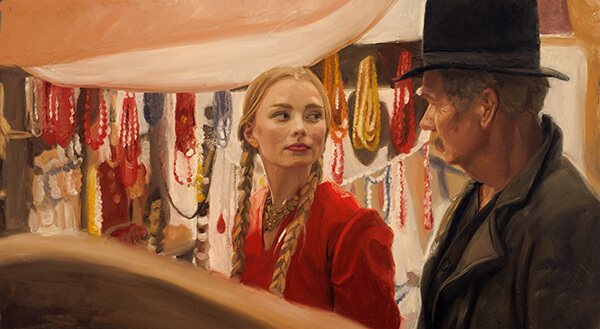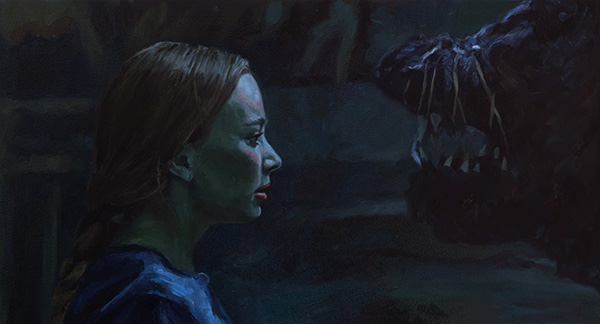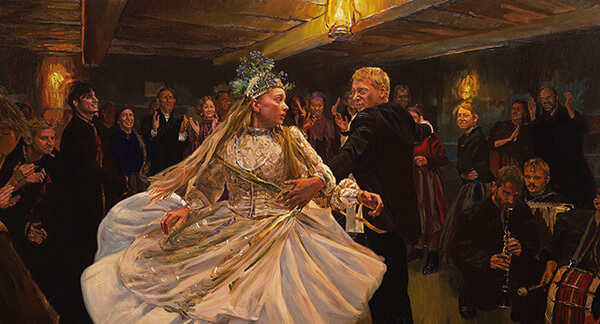The Peasants | Review
Calling Hugh and DK Welchman’s The Peasants a singular achievement may sound like hyperbole. In fact, on its face, it’s inaccurate. The husband and wife duo’s second hand-painted animation is just that, their second, a follow-up to the immensely successful Loving Vincent. That film introduced the industry to what was possible through frame by frame animation of oil paintings on canvas, but you can’t put a superlative like “the world’s first fully hand-painted animated film” back in the box.
However, those thinking the Welchmans are prepared to coast off of the success of their breakthrough outing will need to sit down and watch The Peasants, a film that is to Loving Vincent what black and white cinema is to color. It is such a massive step up in just about every category, massively expanding painting’s potential as a tool for epic animated storytelling that it is, as aforementioned, a completely singular achievement. It is, by all accounts, the most impressive piece of animated cinema one can see this year.
Based on the Nobel Prize-winning early 20th century Polish novel by Władysław Reymont, The Peasants follows Jagna (Kamila Urzędowska), a loving but reckless 19-year-old girl who is the topic of much gossip in her farming village. Beautiful and unmarried, many men in the village seek her affection, including the brutish but charming Antek (Robert Gulaczyk), who himself is married with children. Things get even more complicated when Antek’s father, wealthy farmer Boryna (Mirosław Baka), requests her hand in marriage.

The Peasants (Vertigo Releasing – Image via Alternate Current)
Jagna, an artistic free spirit, is uninclined to be tied down, but her mother (Ewa Kasprzyk) accepts on her behalf after Boryna offers her and her family a considerable amount of land. What follows is a torrid family drama that plays out over four seasonal chapters. As the leaves change color and the weather intensifies, so too does the passion and spite of the conflict.
What’s immediately clear about the Welchman’s latest film is that they have entirely reinvented their filmmaking style, adapting the medium’s creative process to better suit a new story’s needs. Loving Vincent was an ode to the eponymous great painter and, as such, was rendered in his style; backgrounds were recreations of classic Van Gogh paintings, but their static design left much of the film’s additional animation to feel plastered onto images rather than feel like organic parts of an environment. For The Peasants, the Welchmans introduce something that completely changes the game: a dynamic camera.

The Peasants (Vertigo Releasing – Image via Alternate Current)
An extensive amount of live-action photography was filmed and then pseudo-rotoscoped onto canvas, including shots of outdoor locations and makeshift cardboard sets. This creates a stark contrast from Loving Vincent’s green-screen compositing. It breathes new cinematic life into their brush strokes, from expertly blocked long takes and camera movements to a deeply felt ensemble of performances. By constructing the film with a more fluent filmic language, this sophomore film feels volumes richer in design.
The Peasants’ art style takes inspiration from the more photoreal Young Poland art movement, which thrived around the time the film’s story takes place. It’s a similar approach to Loving Vincent but one that merits more exquisitely colored and detailed animation, elevated by strong Polish production and costume design.
Additionally, the film’s heightened drama pairs well with a more kinetic animation style. The Welchmans adopt an in-betweening technique for this film that gives character models a stitchy but lifelike movement that thrives on imperfections (very reminiscent of stop-motion mediums like yarn or clay). It may not be appealing to everyone, but it’s impossible to deny that the animation’s poetic craftmanship soars during sequences with more intense choreography, such as physical brawls and traditional village dances. These majestically realized moments of emotional expression and technical wizardry will leave your mouth agape.

The Peasants (Vertigo Releasing – Image via Alternate Current)
However, the most important difference between Loving Vincent and The Peasants is the story itself. The former, while lovingly in tribute to Van Gogh, was a bit too slow-moving and meditative to sustain its length. Reymont’s novel is a far more complex and gripping tale, a simultaneous ode and lament to rural life and the familial ties that bind, but not the first thing you would think to adapt into animation.
But that’s just bias talking. Anything could make for a strong animated film with the right vision behind it, and the Welchmans’ grounded, pastoral tapestry portrays the heart-wrenching highs and lows as well as any live-action film. Every actor is giving an outstanding performance that pierces through many layers of oil, and the potent themes of class disparity and oppression feel even more powerful when rendered in the curves and edges of laborious, handmade art.

The Peasants (Vertigo Releasing – Image via Alternate Current)
Another resonant theme in the film is female suppression and subjugation in patriarchal communities, which is given far more focus in this retelling of Reymont’s story. Unlike the novel, the majority of the story is seen through Jagna’s eyes – Urzędowska’s face contains such multitudes that you can’t help but want to center it whenever possible.
Much of the film’s tension and aggression is targeted at her, morphing a legendary but stoic novel into a female-focused coming-of-age narrative for the modern day. By the end of the film’s final sequence, harrowing as it is engrossing, you cannot help but be in awe of Jagna’s resilience and how the power of animation gives it incredible potency. Anyone who still doubts the medium as a venue for revelatory filmmaking should make The Peasants a priority.
The Peasants will release in UK cinemas on December 8th.


